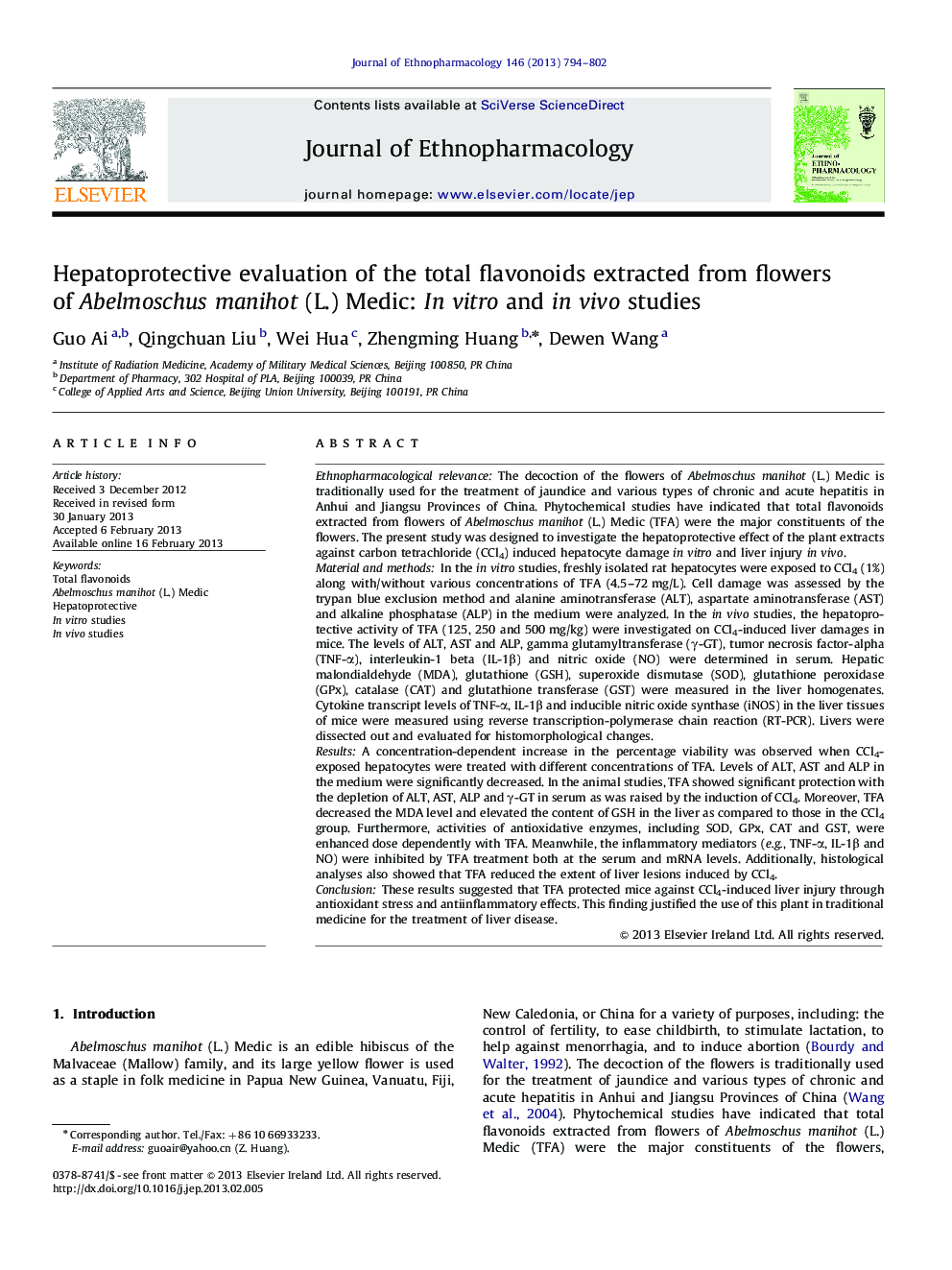| کد مقاله | کد نشریه | سال انتشار | مقاله انگلیسی | نسخه تمام متن |
|---|---|---|---|---|
| 2545489 | 1123959 | 2013 | 9 صفحه PDF | دانلود رایگان |

Ethnopharmacological relevanceThe decoction of the flowers of Abelmoschus manihot (L.) Medic is traditionally used for the treatment of jaundice and various types of chronic and acute hepatitis in Anhui and Jiangsu Provinces of China. Phytochemical studies have indicated that total flavonoids extracted from flowers of Abelmoschus manihot (L.) Medic (TFA) were the major constituents of the flowers. The present study was designed to investigate the hepatoprotective effect of the plant extracts against carbon tetrachloride (CCl4) induced hepatocyte damage in vitro and liver injury in vivo.Material and methodsIn the in vitro studies, freshly isolated rat hepatocytes were exposed to CCl4 (1%) along with/without various concentrations of TFA (4.5–72 mg/L). Cell damage was assessed by the trypan blue exclusion method and alanine aminotransferase (ALT), aspartate aminotransferase (AST) and alkaline phosphatase (ALP) in the medium were analyzed. In the in vivo studies, the hepatoprotective activity of TFA (125, 250 and 500 mg/kg) were investigated on CCl4-induced liver damages in mice. The levels of ALT, AST and ALP, gamma glutamyltransferase (γ-GT), tumor necrosis factor-alpha (TNF-α), interleukin-1 beta (IL-1β) and nitric oxide (NO) were determined in serum. Hepatic malondialdehyde (MDA), glutathione (GSH), superoxide dismutase (SOD), glutathione peroxidase (GPx), catalase (CAT) and glutathione transferase (GST) were measured in the liver homogenates. Cytokine transcript levels of TNF-α, IL-1β and inducible nitric oxide synthase (iNOS) in the liver tissues of mice were measured using reverse transcription-polymerase chain reaction (RT-PCR). Livers were dissected out and evaluated for histomorphological changes.ResultsA concentration-dependent increase in the percentage viability was observed when CCl4-exposed hepatocytes were treated with different concentrations of TFA. Levels of ALT, AST and ALP in the medium were significantly decreased. In the animal studies, TFA showed significant protection with the depletion of ALT, AST, ALP and γ-GT in serum as was raised by the induction of CCl4. Moreover, TFA decreased the MDA level and elevated the content of GSH in the liver as compared to those in the CCl4 group. Furthermore, activities of antioxidative enzymes, including SOD, GPx, CAT and GST, were enhanced dose dependently with TFA. Meanwhile, the inflammatory mediators (e.g., TNF-α, IL-1β and NO) were inhibited by TFA treatment both at the serum and mRNA levels. Additionally, histological analyses also showed that TFA reduced the extent of liver lesions induced by CCl4.ConclusionThese results suggested that TFA protected mice against CCl4-induced liver injury through antioxidant stress and antiinflammatory effects. This finding justified the use of this plant in traditional medicine for the treatment of liver disease.
Figure optionsDownload high-quality image (177 K)Download as PowerPoint slide
Journal: Journal of Ethnopharmacology - Volume 146, Issue 3, 19 April 2013, Pages 794–802